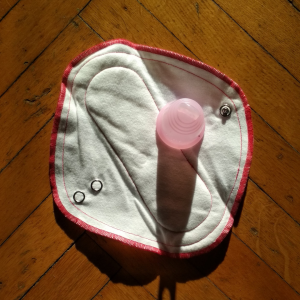Because of the beginning of a new year and the celebration of my blog beeing online for six months now, I translated the most read article on the blog from last year to English! So enjoy or check out the original (in german) here 😉
First of all I would like to say that I think it is very important that every woman knows exactly what she likes and if those are not ZeroWaste products in this area of life, that should be perfectly OK! I was a bit hesitant in the beginning, but after some trial and error I got used to my best ZeroWaste menstrual variation: the menstrual cup. More about this below!
Why the step towards ZeroWaste menstrual hygiene at all?
Here are a few more hard facts*:
We women need about 10,000 to 17,000 pads or tampons in our lives.
… for approx. 500 periods!
These pads and tampons have to be bought expensively, disposed of somewhere after usage and unfortunately often end up in our oceans. Many conventional pads and tampons also contain plastic fibres which are not only harmful to the environment but also to the body. Who would simply push a piece of plastic into their own vagina and assume that it can be healthy?
The alternatives
1. not garbage-free yet, but at least organic quality and degradable: pads and tampons made of organic cotton and without additives.
2. the menstrual cup: my absolute favourite! The menstrual cup is inserted into the vagina just like a tampon and keeps itself in the right place through a vacuum seal. The insertion is achieved by folding the cup in different ways: e.g. C, S, or a bent U – PunchDown – fold. Here you will also find a great video, where the folds and also causes for a leak are better explained (in german). At first I didn’t get along so well with my cup, but then I tried a different fold and that increased the comfort and the security against leakage considerably!
In the beginning I would recommend to simply try a cup. There are usually two sizes and different brands. Please, however, use one that is medically certified silicone! Try out the insertion, different ways and the removal in a peaceful moment at home. Rinse the cup briefly with water before inserting it, this will make the procedure even easier. For example, I changed my cup as often as possible in the shower at the beginning. Then it doesn’t matter if something goes wrong. But after some time I got the hang of it and don’t have a bloodbath in the toilets anymore. With a little humour and curiosity, I’m sure that at some point a woman will find out how to handle it correctly.
Important is the cleaning before, during and after the period. Before and after please let it simmer for about 2 minutes in boiling water and rinse it with water while changing or at least wipe it with paper if there is no water available (water bottle, toilet with sink etc.).
In my opinion the advantages of the cup are manifold: environmentally friendly, inexpensive, pleasant, astonishing because of the insight into one’s own menstruation, getting to know oneself and one’s menstruation and vagina better, practical for on the go! In any case, I have a completely different view of my period, the amount of blood, the colour and consistency and can also deduce whether anything has changed since the last menstruation.
Update: there is a menstrual cup group on Facebook where you can get advice on the right choice.

3. fabric pads: these are now available in some unpackaged shops or online and are used just like traditional pads. I have one for the night, so to speak as security. But there are also workshops or instructions on the Internet on how to easily sew such bandages yourself. Just keep your ears and eyes open!
4. period underwear: More and more of these panties have been coming onto the market for a few years now. On the outside they look like normal underwear, but can hold up to three tampons of menstrual blood, depending on brand and model. Then they are washed with the laundry and can be reused every month.
5. sponges: I have also heard of period sponges that are inserted into the vagina instead of a tampon. Made of natural materials and biodegradable, of course. But there are also some made of plastic. I have not yet tested them myself and can therefore not say whether I would recommend them.
6. free bleeding/free menstruation**: it is said that through training it is possible to bleed in a controlled way on the toilet. Similar to normal urination, then with the menstrual blood, because the blood also comes in waves that can be noticed. I haven’t tried that myself yet, but maybe one of you already has experiences with it that she would like to share!
If you’ve now became super curious and want to learn more about your menstruation, the cycle and the sustainability of your life, then I’d like to share this with you. I am hosting a workshop on ZeroWaste and the female cycle on March 2nd of this year. Come by if you want to get more involved with the female cycle and waste reduction in this context. The workshop is open to all genders and will be held in German.
I am looking forward to your comments, registrations and feedback and hope you dare to take the step towards a garbage-free period!
Your Marolena 🙂
Further links:
*www.erdbeerwoche.com/meineregel/wusstest-du.html
**https://derstandard.at/2000069037292/Free-Bleeding-Auf-Binden-und-Tampons-verzichten


